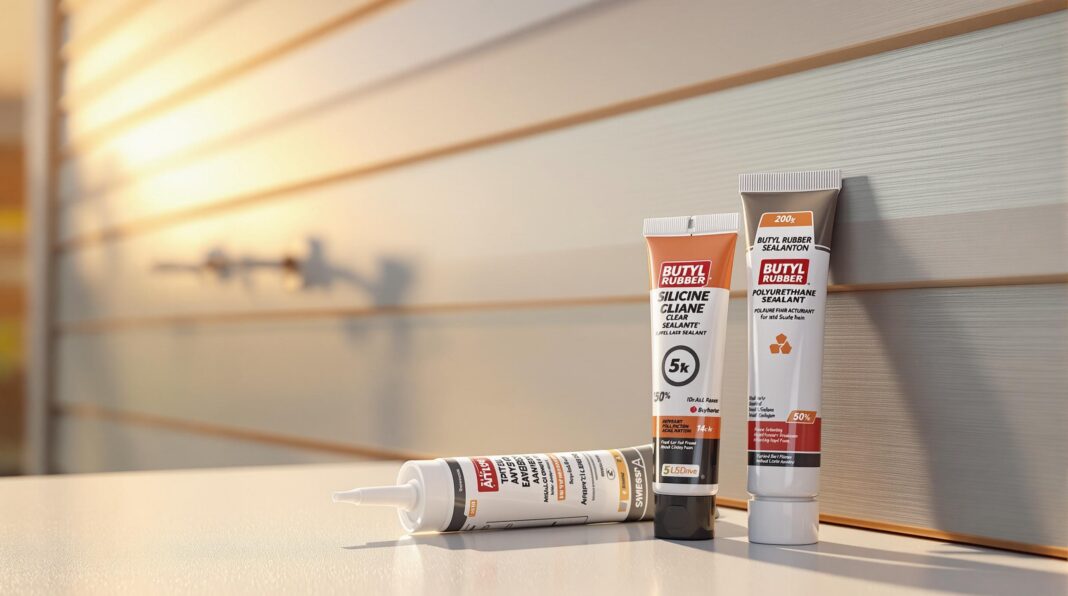When protecting metal siding, choosing the right sealant is crucial to prevent moisture damage, rust, and corrosion. Here’s a quick breakdown of the most popular options:
- Silicone Sealants: Long-lasting, highly weather-resistant, and ideal for areas with extreme temperatures or UV exposure. Not paintable.
- Polyurethane Sealants: Strong adhesion, paintable, and good for general use. Vulnerable to UV exposure and slower to cure.
- Butyl Rubber Sealants: Best for moisture-heavy environments, offering excellent water resistance but shorter lifespan compared to other options.
Quick Comparison
| Feature | Silicone Sealants | Polyurethane Sealants | Butyl Rubber Sealants |
|---|---|---|---|
| Durability | High | Moderate | Low |
| Weather Resistance | Excellent | Good | Adequate |
| Paintable | No | Yes | No |
| Best Use Case | Harsh climates | General use | High-moisture areas |
Pick a sealant based on your climate, project needs, and maintenance preferences. Always follow manufacturer instructions for the best results.
The Key Differences Between Polyurethane Sealants And Silicone
1. Silicone Sealants
Silicone sealants are known for their durability and ability to withstand harsh weather conditions, even across a wide range of temperatures.
Key Benefits
- UV Resistance: These sealants hold up well under UV exposure, retaining their flexibility and color over time.
- Movement Capability: They handle expansion and contraction in metal surfaces with ease, making them ideal for joints that experience frequent movement.
Application Guidelines
Before applying silicone sealants, ensure surfaces are clean, dry, and free of oils or old sealant residue. Follow the manufacturer’s instructions for priming if needed.
Performance Overview
| Characteristic | Rating | Notes |
|---|---|---|
| Weather Resistance | High | Performs well in varying temperatures |
| UV Stability | Outstanding | Maintains its protective properties |
| Joint Movement | Excellent | Adapts to metal expansion and contraction |
| Cure Time | Variable | Depends on humidity and temperature |
Cost and Maintenance
While silicone sealants may have a higher initial cost, their longevity and minimal maintenance make them a smart long-term investment. Once cured, they stay flexible and effective, requiring only annual inspections to spot potential damage.
Application Tips
- Apply under the conditions recommended by the manufacturer.
- Use masking tape to achieve clean edges.
- Smooth (or “tool”) the sealant immediately after application.
- Allow it to fully cure before exposing it to moisture.
- Important: Most silicone sealants are not paintable. If you need to paint over the sealant, opt for a paintable version.
Next, we’ll dive into polyurethane sealants and compare their features to silicone options.
2. Polyurethane Sealants
Polyurethane sealants are known for their strong adhesion and durability, offering a reliable shield against moisture and harsh weather conditions across various U.S. climates.
Performance and Durability
With proper upkeep, polyurethane sealants can withstand weather changes, adhere tightly to surfaces, adapt to metal movement, and remain paintable once cured.
Application Process
Start by thoroughly cleaning the metal surface. Apply the sealant under conditions recommended by the manufacturer, adhere to proper joint design guidelines, and tool the sealant quickly to ensure a secure bond. Since the application process can involve chemical fumes or airborne particles, it’s advisable to wear eye protection goggles to safeguard your vision. High-quality eye protection goggles provide a clear view while shielding your eyes from irritants, making them essential for any sealant job.
Maintenance and Limitations
Regular inspections can help identify early signs of wear, such as reduced flexibility or separation from the surface. While polyurethane sealants are built for long-term use, they take longer to cure compared to silicone options and are more vulnerable to extended UV exposure. Some formulations might also show slight discoloration over time.
Cost Considerations and Expert Insights
These sealants are moderately priced, offering good value due to their durability and performance. Experts advise selecting a sealant that’s flexible enough to handle the seasonal expansion and contraction of metal siding. For additional application tips and home improvement advice, resources like Home Base Project (https://homebaseproject.org) can be helpful for both DIY enthusiasts and professionals.
This makes polyurethane a solid choice, setting the stage to dive into butyl rubber sealants next.
3. Butyl Rubber Sealants
Butyl rubber sealants are a go-to choice for creating a strong barrier against moisture. Their water resistance and excellent adhesion make them perfect for areas with high humidity or frequent exposure to water.
Key Properties and Performance
These sealants create tight, waterproof seals that help block moisture from seeping in. They are flexible and bond well, which is crucial for metal siding that can expand and contract with weather changes. They also hold up well under UV exposure and harsh weather when maintained properly. While silicone and polyurethane sealants are also highly protective, butyl rubber stands out in areas prone to moisture.
Application Guidelines
To get the best results:
- Clean the surface: Use a wire brush to remove dirt, rust, and loose paint from the metal.
- Prime the area: Apply a primer designed for metal to bare or rusty spots for better adhesion.
- Apply the sealant: Use a caulking gun to spread the sealant evenly along the joint.
- Smooth the bead: Use a putty knife to create a neat, watertight finish.
Maintenance Requirements
Check the sealant regularly for signs of separation, cracks, or reduced flexibility, and make repairs as needed to maintain its effectiveness.
Professional Insights
For areas like corners and seams that need extra moisture protection, applying an additional bead of sealant can provide added security. Keep an eye on high-stress areas and touch up the sealant as necessary. Refer to the Sealant Comparison Chart below for more detailed evaluations.
Sealant Comparison Chart
Here’s a quick comparison of silicone, polyurethane, and butyl rubber sealants for metal siding, highlighting their durability and ability to withstand different weather conditions:
| Feature | Silicone Sealants | Polyurethane Sealants | Butyl Rubber Sealants |
|---|---|---|---|
| Durability / Lifespan | Offers a longer lifespan | Provides moderate durability and lifespan | Typically has a shorter lifespan |
| Weather Resistance | Excels in harsh weather conditions | Performs well against weather changes | Adequate for standard conditions |
Keep in mind: Actual results depend on environmental factors and how well the sealant is applied. Always check the manufacturer’s instructions to ensure the best outcome.
Use this guide to pick the sealant that suits your project best.
Which Sealant to Choose
Using the performance data mentioned earlier, here are some targeted tips to help you pick the right sealant:
- Silicone sealants are a top choice for their durability and ability to withstand harsh weather. They’re perfect for areas with:
- Large temperature swings
- Coastal salt exposure
- Intense, direct sunlight
- Polyurethane sealants strike a good balance between strong adhesion, UV resistance, and affordability, making them a solid option for a variety of climates.
- Butyl rubber works well for budget-friendly projects or areas with minimal exposure to harsh conditions.
Always review the manufacturer’s compatibility guidelines to ensure the sealant works with your specific metal siding before making a final decision.


